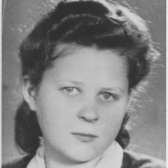
Nina was born to a Jewish family in the Polish town of Rokitno (now Rokytne, Ukraine). She was the youngest of three siblings. Her father worked as a builder, and was a jack-of-all-trades. Nina attended Beth Sefer Tarbut, one of the city’s finest private Hebrew schools. In 1939 the Soviets occupied Rokitno, closed the Hebrew school, and reopened it as a Yiddish school. She began to attend a Russian-Ukrainian public school instead. In 1941, the Germans invaded the Soviet Union, and Rokitno came under German occupation. Harsh anti-Jewish measures were immediately implemented.
Before a ghetto was established, Nina and her family moved to the small village of Glinno (now Hlynne, Ukraine), where most of her father’s family lived. Nina did not stay long there, because the Germans gathered the Jews from the surrounding area and established a ghetto in the village of Berezów (now Berezove, Ukraine). Everybody was forced to work for the Germans' occupation authorities without pay. In September 1942, the German SS with Ukrainian helpers surrounded the Berezów ghetto with the intention of killing all the inhabitants.
Nina escaped to the woods and hid there for several days. There, she met her uncle and his two daughters. Nina and other escapees from the ghetto joined the Ukrainian partisans. Befriended by her commander, Sydor Artemovych Kovak, she was sent to Moscow to study until the end of the war. Nina was sent on vacation to Poland to find her relatives; instead of returning she joined a kibbutz. Nina emigrated to the United States on February 18, 1947. She lived with her mother’s sister and her family in Washington, D.C., where she was schooled. She met her husband-to-be, Leon, at a party in her house and they were soon married. Leon is also a Holocaust survivor.
